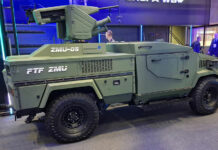AeroVironment (AV) is proceeding with the development of the Nano-Air-Vehicle, under a $2.1 million phase II contract recently awarded by DARPA. Last December, AV has accomplished the first technical milestone in this program – the controlled hovering flight of an air vehicle system with two flapping wings that carries its own energy source and uses only the flapping wings for propulsion and control. The ‘Mercury’ interim test vehicle conducted a 20-second flight during this test. The nano aircraft is capable of climbing and descending vertically, flying sideways left and right, as well as forward and backward, under remote control.“The goals of the NAV program will stretch our understanding of flight at these small sizes and require novel technology development.” said Dr. Todd Hylton, DARPA program manager. He indicated the goals set for the 10 gram aircraft were to be able to hover for extended periods, fly at forward speeds up to 10 meters per second, withstand 2.5 meter per second wind gusts, operate inside buildings and have up to a kilometer command and control range. The NAV program was initiated by DARPA to develop a new class of air vehicles capable of indoor and outdoor operation. Employing biological mimicry at an extremely small scale this unconventional aircraft is designed to provide new military reconnaissance capabilities in urban environments.
“The NAV program will push the limits of aerodynamic and power conversion efficiency, endurance, and maneuverability for very small, flapping wing air vehicle systems,” Dr. Hylton added, “There are still many hurdles to achieve the vehicle we envisioned when the program was started, but we believe that the progress to date puts us on the path to such a vehicle.”
“From the first day of the Phase I effort, we knew that our biggest challenge would be to develop a viable propulsion system, followed by the extreme challenge of creating a control system for such complex operation at such a small scale,” said Matt Keennon, AV’s project manager and principal investigator on the NAV project. “Both systems were extremely difficult to conceive and required an intense combination of creative, scientific, and artistic problem-solving skills from several key team members. Our progress has been possible only because of the unique R&D environment at AV.”
Keennon said the Phase II effort will focus on optimizing the aircraft for longer flight endurance, establishing the transition capability from hover to forward flight and back, and reducing its size, weight, and acoustic signature. “All of these are distinct technical challenges in their own right that actually conflict with each other, making for an interesting and exciting path ahead,” he said. The current phase is scheduled to continue through summer 2010.
















